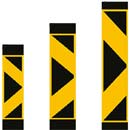DELINEATORS & BASES
A) Delineator Definition and Usage
Traffic delineators are important for safely guiding traffic through confusing construction or potentially hazardous road conditions. They offer visible boundaries for areas to help delineate changes in traffic flow, alerting drivers to special road conditions like curved areas of the road, on and off ramps, and other unexpected road changes or potential safety concerns.
(B) General Delineator Specifications
· The most important requirements of delineators is that they be visible at a distance in normal atmospheric conditions.
· They must be made to withstand vehicle impact and for this reason are typically made of flexible recycled plastic.
· When using Retroreflective sheeting on a delineator, the sheeting stripes should always be at least 3 inches apart.
(C) Placement and Spacing for Delineators
The correct spacing of delineators may vary anywhere from 20 feet to over 500 feet depending on how they are being used. Delineators
on ramps and curves are typically required to be spaced closer together while longer straight stretches of road require fewer delineators.
The shorter the radius of the curve, the closer the delineators need to be placed. As a general rule, delineators must be set up so that
several delineators are visible at the same time to the driver. Delineators should be placed the same distance from the edge of the road
as consistently as possible, unless there is an object obstructing placement. The acceptable standard is typically between 2 to 8 feet.

Delineators
Type B1 800 x 200 mmType C2 1000 x 250 mm
Type D2 1200 x 250 mm
Uses
To divert traffic for road construction and maintenanceTo guide road users at night or during poor visibility conditions
Available in various grades of reflection
Bases are manufactured from regrind PVC. Due to the weight advantage, it offers free standing options. These products are extremely durable and cost effective.

Leight Weight Base
600g plastic baseUses
To stabilise delineatorsSandbags may be required for extra stability

Heavy Base
2.5kg base
4.5kg base
10kg base
Uses
To stabilise delineatorsNo sandbags required